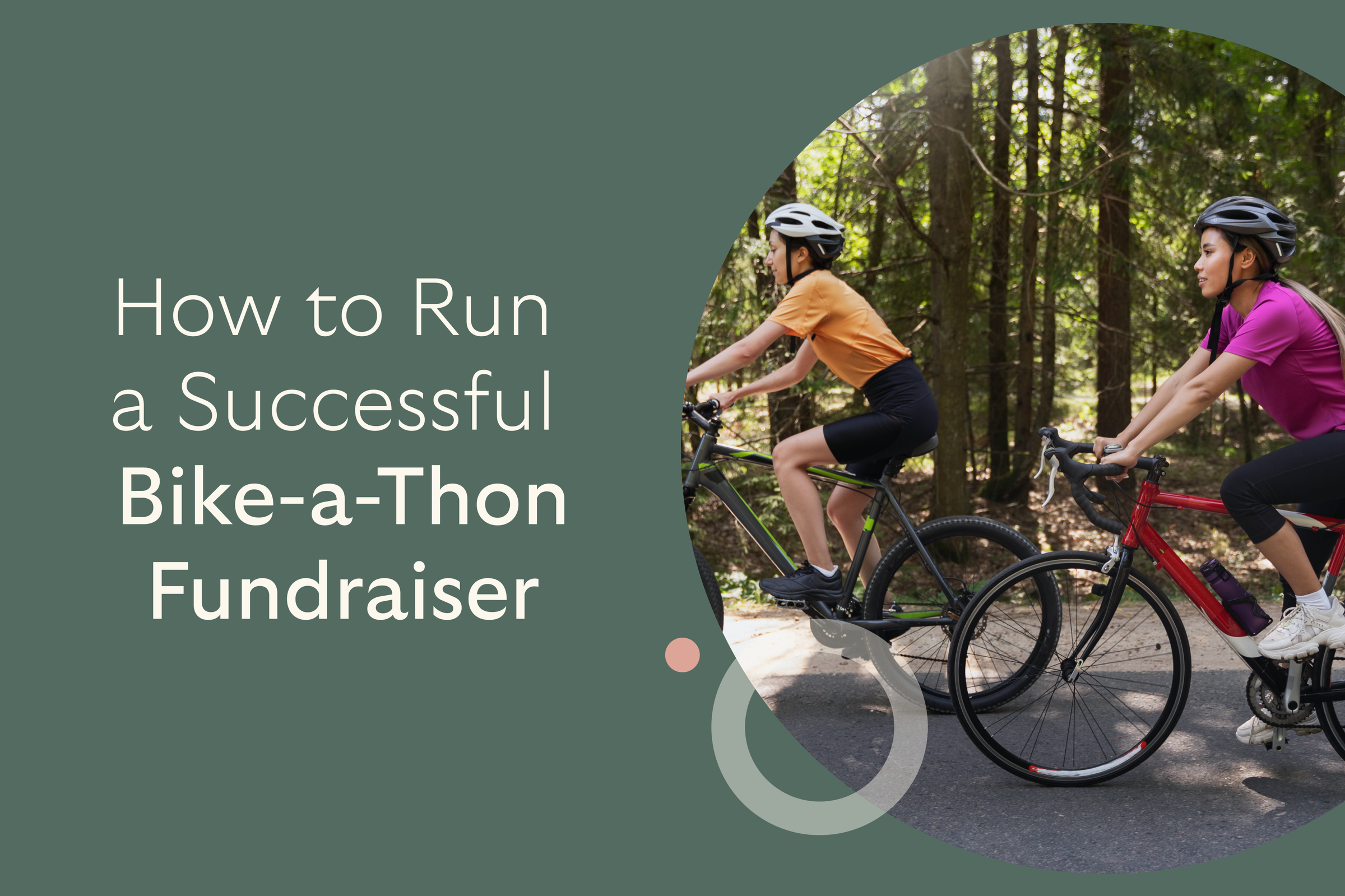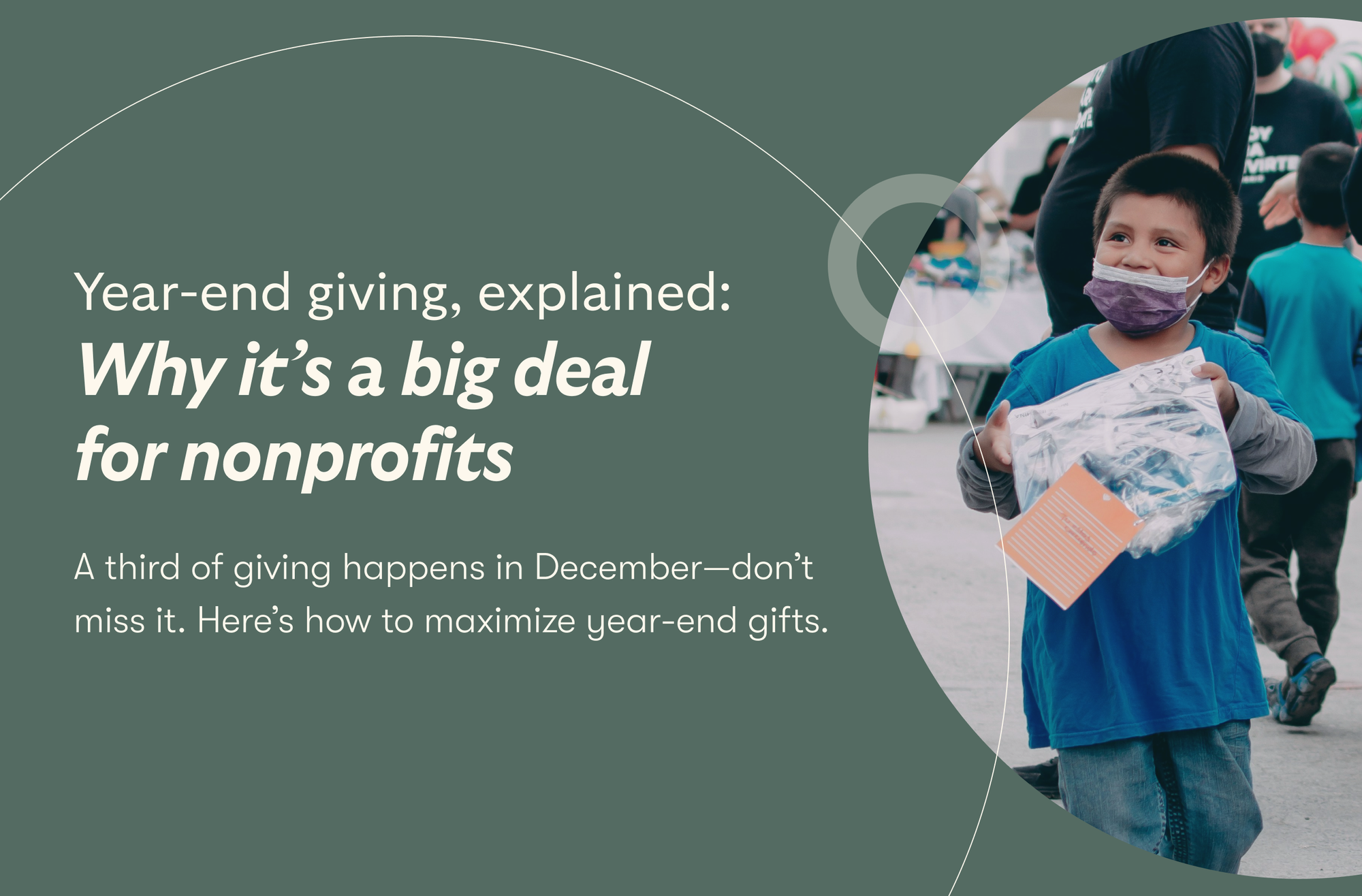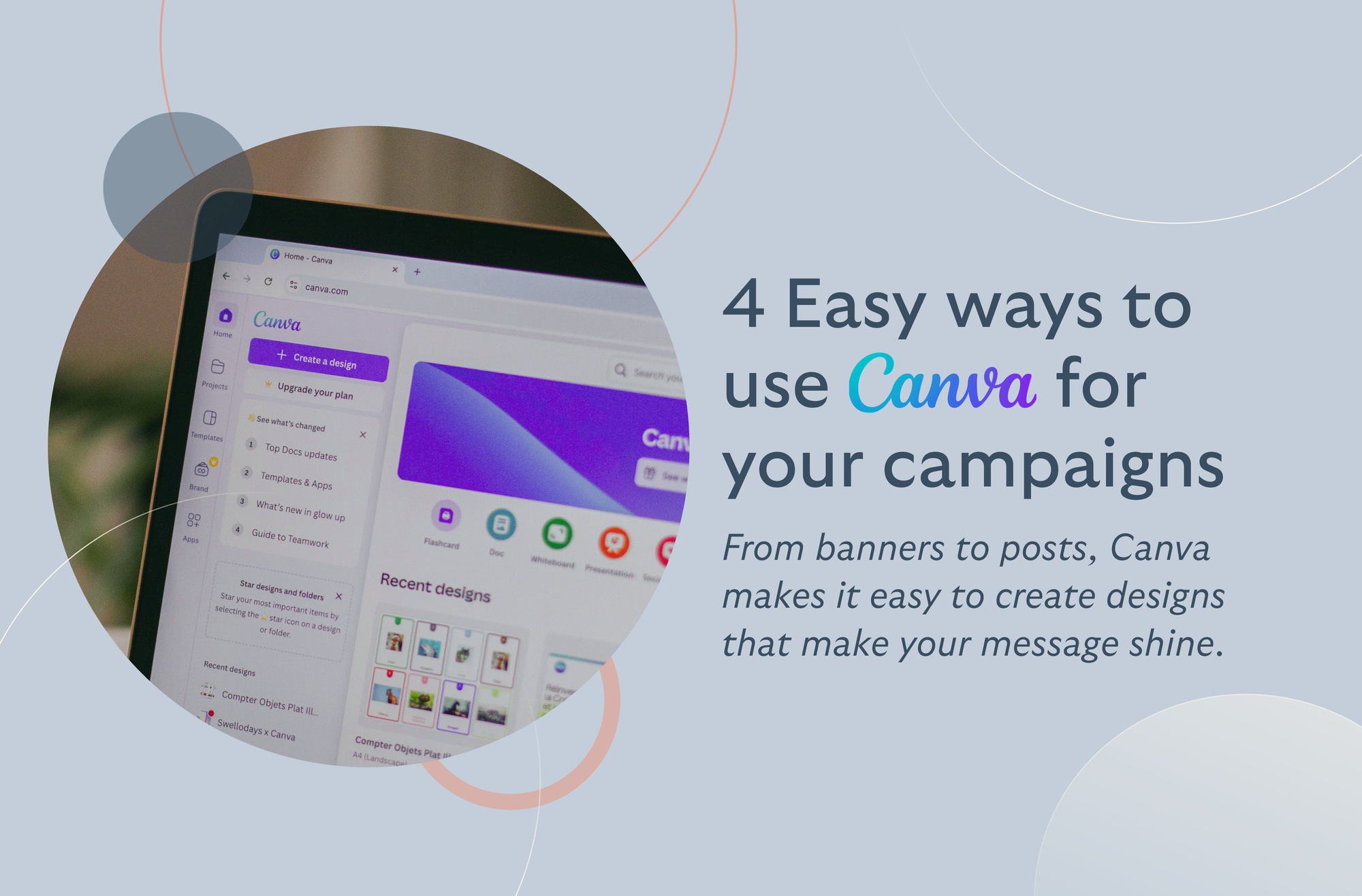Video Integration — boost the buzz around your online fundraising campaign
Time-saving – thoughtful automations save dozens of hours over your campaign
One-Click Checkout — our system will automatically charge the lucky winner
Text Message Notifications — keep your bidders engaged with text message notifications
How to Run a Successful Bike-a-Thon Fundraiser
By Colin Hunter

If your nonprofit is looking for a fun way to raise money and involve the community, a bike-a-thon fundraiser could be the perfect choice. Bike-a-thons are easy to set up, great for families, and encourage healthy activity.
Participants collect pledges from friends, family, or local businesses based on how far they ride. It's a win-win because riders enjoy a fun day out while your organization raises funds for important projects.
This guide provides simple steps for planning your bike-a-thon fundraiser, helpful tips for attracting more participants, and ways to make your event enjoyable for everyone involved.
What Is a Bike-a-Thon Fundraiser?
A bike-a-thon fundraiser is an event where people raise money for a nonprofit by riding bicycles.
Participants usually ask friends, family, and neighbors to sponsor them. Sponsors promise to donate a certain amount of money for each mile biked or give a fixed amount for finishing the event.
Bike-a-thons can take many forms. Sometimes, it's a fun, short ride around a neighborhood park. Other times, it's a longer ride spanning several towns.
No matter how big or small, bike-a-thons get people excited about helping a good cause. They are easy to organize and popular with all ages, which makes them great for schools, churches, and community nonprofits.
One of the best-known examples of a bike-a-thon is the Pan-Mass Challenge. In 2022, it set a record by raising $66 million for cancer research. That shows how much potential a bike-a-thon fundraiser can have if done right.
If your nonprofit wants to host a bike-a-thon, you're choosing a proven way to get your community involved, raise money, and spread the word about your cause.
Why Choose a Bike-a-Thon Fundraiser?
- Easy to Organize: You don’t need special skills—just bikes and riders.
- Low Cost: Running a bike-a-thon fundraiser won't break your nonprofit’s budget.
- Healthy Activity: Participants can stay active while supporting your cause.
- All Ages Welcome: Everyone, from kids to grandparents, can join.
- Community Involvement: Bring your neighborhood together around a common goal.
- Flexible Format: You decide the distance, location, and difficulty level.
- Proven Success: Many nonprofits have raised lots of money with bike-a-thons.
- Easy Fundraising: Riders raise money through sponsors who pledge donations.
- Great Visibility: A bike-a-thon fundraiser helps people learn about your nonprofit.
- Repeatable Event: Once you run a successful bike-a-thon, it’s easy to make it yearly.
Step #1: Set Clear Goals and Objectives
Before you get your bike-a-thon fundraiser rolling, set clear goals. Knowing exactly what you want to achieve helps keep your event focused and organized. Start by defining:
- Fundraising Amount: How much money do you hope to raise? Set a specific target so participants know exactly what they're working toward.
- Participant Engagement: How many riders or volunteers do you want to involve? This number will affect your planning and resources.
- Awareness: Do you want to spread the word about your cause to a wider community, or are you aiming for deeper connections with existing supporters?
Setting goals is easier if you look back at your previous events or check out similar fundraisers. If last year’s bike-a-thon brought in $5,000 and 50 participants, setting a target of $6,000 and 60 riders could be realistic.
Avoid setting goals that are too high because that might discourage your team. Goals that are challenging but achievable work best.
Also, think about how you'll raise money—will you use a pledge-based model or charge participants a flat fee? Pledge-based means people promise a certain amount for each mile or lap biked. It encourages riders to do their best and raise more money.
On the other hand, a flat fee is simpler. Participants pay once to join. Decide which model suits your nonprofit’s needs, community, and the goals of your bike-a-thon fundraiser.
Lastly, set a budget for your event. Include costs for things like permits, supplies, refreshments, and marketing. Keep track of these expenses to manage the money you raise effectively.
Step #2: Assemble a Planning Committee
The next step in running your bike-a-thon fundraiser is creating a strong planning committee.
Your committee will keep the event organized from start to finish. Look for diverse members with different backgrounds and skills. Your committee should include:
- Staff members: People familiar with your nonprofit's daily operations and goals.
- Board members: Leaders who can guide important decisions and connect you to valuable contacts.
- Volunteers: Dedicated supporters who offer their time and unique skills.
- Event management experts: Individuals experienced with planning events smoothly.
- Marketing specialists: People who know how to attract attention and spread the word.
- Fundraising pros: Members experienced in raising money effectively.
Once your committee is in place, delegate clear roles.
Assign one person to manage logistics, such as securing permits, choosing routes, and arranging safety measures for the bike-a-thon.
Another member should handle sponsorship outreach by connecting with local businesses and organizations for support. A marketing lead can create materials like flyers, social media posts, and email announcements to attract participants and donors.
Lastly, appoint someone to coordinate volunteers, ensuring you have enough helpers for registration, setup, and cleanup on the event day.
Step #3: Plan Your Bike-a-Thon Event
Planning your bike-a-thon fundraiser requires thoughtful preparation to ensure your event is enjoyable, safe, and successful.
Choose a day that avoids conflicts major local events by checking community calendars, and aim for a time of year when the weather is typically pleasant for biking.
Next, pick a route for your bike-a-thon that's safe and easy to reach.
Make sure the path suits all kinds of riders, from beginners to advanced cyclists. A good route is smooth, clearly marked, and doesn't have too much traffic. Also, include shorter and longer options so more people feel comfortable joining.
You'll likely need permits or approval from local authorities to host your bike-a-thon. Contact city or county offices early to secure permission.
Plan carefully for safety, including checkpoints with hydration stations and medical aid along the route.
Finally, consider important logistics like clear signage along the bike-a-thon route to keep riders on track and everyone safe.
Check with local authorities about any necessary road closures. Plan for volunteers to help direct riders, hand out supplies, and set up or take down equipment.
Step #4: Recruit Participants and Volunteers
Get enthusiastic people involved in your bike-a-thon fundraiser to make it a success. Participants will ride and raise funds; volunteers will help keep things organized.
Here are some practical tips for recruiting participants and volunteers:
- Share the event on social media to reach your community.
- Ask past supporters or event participants to join again.
- Partner with local cycling clubs or sports groups.
- Put posters and flyers in community centers, gyms, schools, and businesses.
- Encourage current volunteers and staff to spread the word.
When reaching out, clearly explain why you're hosting the bike-a-thon and how the funds raised will help your cause. Let participants know their efforts make a real difference.
Highlight benefits such as staying active, community building, and supporting a meaningful goal. The clearer your message, the more motivated people will feel to join your event.
Managing volunteers effectively ensures everything runs smoothly on event day. Here are a few tips to keep volunteer tasks and responsibilities organized:
- Clearly define volunteer roles ahead of time.
- Provide a short training session before the bike-a-thon begins.
- Create simple checklists for each volunteer task.
- Assign team leaders to oversee groups of volunteers.
- Keep open communication so volunteers know who to contact if they have questions.
Step #5: Secure Sponsors and Donations
Sponsors can play an important role in your bike-a-thon fundraiser. They can provide funds and products to support your event, making it more enjoyable for everyone.
Approaching local businesses doesn't have to be complicated. Here are a few simple ways to get started:
- Visit businesses personally to introduce your nonprofit and the bike-a-thon.
- Write clear and friendly letters or emails explaining the event.
- Use connections from your staff, board, or volunteers to reach out to business owners.
- Post about sponsorship opportunities on your nonprofit’s social media pages and website.
- Attend local business meetings or chamber of commerce events to meet potential sponsors.
When asking for sponsorship, be clear about what you’re offering in return. Sponsors want to see exactly how their support benefits both your event and their business.
Create simple sponsorship packages that clearly list benefits. For example, you might offer logo placement on event banners, t-shirts, or promotional materials.
Businesses appreciate seeing their name clearly connected to a positive community activity.
You can also secure product donations like water, snacks, or prizes to reduce your event costs. Here are easy ways to get product donations:
- Ask local grocery stores or supermarkets for bottled water and snacks.
- Approach restaurants for gift cards or coupons as participant prizes.
- Request sports stores to donate helmets, bike accessories, or gift baskets.
- Connect with companies that regularly support local events—they’re often willing to contribute.
Offering sponsorship levels helps businesses see exactly how their donation impacts your event. For instance:
- Bronze Level ($100): Name listed on your website and event materials.
- Silver Level ($250): Logo placement on banners, website, and social media mentions.
- Gold Level ($500+): Premium logo placement, shout-outs during the bike-a-thon, and featured posts highlighting their support.
Looking for Athon Fundraisers? Here are 17 Best Athon Fundraisers For Your Nonprofit.
Let us help you raise more! Use BetterWorld’s free, easy fundraising tools!
Step #6: Promote Your Bike-a-Thon Event
The better you promote your bike-a-thon fundraiser, the more successful and engaging it will be for your nonprofit and the community. It's important to use both online and offline strategies to reach as many people as possible.
Social media, local media, and community outreach all make your event stand out.
Social media is a great way to create buzz around your bike-a-thon. Here are simple tips to use platforms like Facebook, Instagram, and TikTok effectively:
- Post regularly about the event, including updates, countdowns, and participant stories.
- Share short videos and photos from previous events or behind-the-scenes preparations.
- Use hashtags related to your event and cause to reach a wider audience.
- Encourage followers to share posts with their own networks.
- Create fun and engaging content, like participant challenges or short clips of training rides.
Reach out to local media to spread the word. Here’s how to get your bike-a-thon noticed by local newspapers, radio stations, and community newsletters:
- Write a simple press release that clearly explains the event and its purpose.
- Contact local reporters or editors directly by phone or email.
- Highlight the personal stories of participants or volunteers to make your event relatable.
- Offer interviews with your nonprofit’s leaders or key participants to add interest.
- Provide clear details on how community members can get involved or support the event.
Attractive flyers and posters can boost your visibility locally. Make sure these materials include clear information like date, time, location, and registration details.
Bright colors and simple designs catch people’s eyes quickly. You might feature pictures of past bike-a-thon events, friendly participant photos, or clear graphics of bikes and routes.
Place these flyers in community centers, libraries, coffee shops, gyms, and schools to reach potential riders and volunteers.
Step #7: Participant Registration and Fundraising
Ready to make participant registration effortless and raise more money for your bike-a-thon fundraiser? BetterWorld Ticketing Software is the easiest and smartest way to handle your event registration.
With our free and user-friendly platform, your nonprofit can quickly set up customized donation pages, sell tickets online, and keep track of offline ticket sales without hassle.
And on the day of your bike-a-thon, our simple check-in system saves time, so you can focus on making your event memorable.
But BetterWorld doesn’t just make registration easy—it also boosts your fundraising power. Our Easy A-Thon Fundraising Tools give your participants full control to personalize their fundraising experience.
Participants can form teams or raise funds individually, creating their own pages with personal stories and photos. When donors see why someone is riding in your bike-a-thon, they feel connected and inspired to give more generously.
Another effective way to boost participation in your bike-a-thon fundraiser is offering incentives. Participants feel excited when there's a little extra reward for their effort.
Consider giving small prizes, certificates, or special recognition to the top fundraisers or teams. Friendly competition can encourage more fundraising and motivate everyone to reach your nonprofit’s goals.
Why not try our Modern Fundraising Tools and Online Fundraising to raise funds for your nonprofit? You get all the fundraising solutions in one place for zero cost!
Step #8: Manage Event-Day Operations
Event day has arrived! Managing your bike-a-thon fundraiser carefully from start to finish will make the day run smoothly and safely.
Here’s a simple step-by-step guide to keep everything organized:
- Participant Check-In: Set up a clear check-in area. Volunteers can welcome participants, confirm registration, hand out rider numbers, and provide event details.
- Safety Briefing: Gather participants before the ride starts. Clearly explain the route, safety rules, and what to do if someone needs help during the ride.
- Ride Start: Have volunteers guide participants to the starting line. Give a clear signal or announcement to officially begin your bike-a-thon.
- Ride Completion: Set up a clear finish line. Volunteers can greet participants as they finish, record times if needed, and hand out refreshments or prizes.
Safety is extremely important during your bike-a-thon. Make sure you set up hydration stations along the route to keep participants refreshed.
Have emergency plans ready with clear contacts for medical support. Volunteers should know who to contact if someone gets hurt or needs assistance.
Volunteers have key roles on the event day. Some important jobs include:
- Route Marshals: Positioned along the route to direct riders, control traffic, and assist if riders need help.
- Medical Support Volunteers: Ready to offer first aid if someone gets hurt or feels unwell.
- Logistics Coordinators: Oversee setup, supplies, and ensure the event runs according to plan.
Good setup and signage will help riders easily navigate the bike-a-thon route. Before anyone arrives, clearly mark the course with signs, arrows, and cones.
Make sure all equipment, like tents, tables, and water stations, are set up early.
Lastly, have staff and volunteers stationed throughout your bike-a-thon route. They can assist participants, monitor safety, and quickly respond to any issues. Keeping eyes on the event at all times helps everyone stay safe and have a great experience.
Step #9: Maximize Fundraising
Get creative and give participants fun ways to bring in donations.
For example, you can let riders ask donors to pledge a certain amount per mile biked. This motivates them to ride farther and brings in more money. You could also set up fixed donations, where donors simply give a set amount.
Another great idea is to create friendly competitions between teams to see who can raise the most funds. Small prizes or recognition can inspire everyone to do their best.
Encouraging online donations makes it easy for more people to support your event. BetterWorld’s Online Donation Platform is designed to help your nonprofit raise more funds online. In just five minutes, you can have your donation page up and running.
Nonprofits using BetterWorld typically see a 20% increase in donations because the platform is simple and easy for donors to use. Request a free demo now.
Finally, make sure donors understand exactly how their donations make a difference. Clearly share the impact their contributions will have.
You can say things like, “Every $25 raised provides school supplies for a local child,” or “Every $100 helps maintain bike paths for our community.” When donors see exactly where their money goes, they're more likely to give and feel proud about supporting your cause.
Step #10: Post-Event Activities
After your bike-a-thon fundraiser wraps up, it's important to celebrate everyone's efforts. Hosting a closing ceremony is a great way to thank participants, announce the amount of money raised, and highlight special achievements.
A simple event with snacks, music, and friendly awards helps everyone feel valued and proud of what they've accomplished together.
Next, take some time to gather feedback. Ask participants and volunteers how they felt about the event by giving them a short, easy-to-answer survey.
This feedback helps you understand what went well and what could be improved for next time. Keep questions simple, like “Did you enjoy the route?” or “Would you participate again next year?”
Expressing gratitude is also key to keeping donors and volunteers involved. Send personalized thank-you emails or notes to everyone who contributed—donors, sponsors, and volunteers.
Let them know their support was important and appreciated. Personal touches like mentioning specific things they did or gave make people feel connected and valued.
Finally, clearly share the impact of your bike-a-thon fundraiser. Use social media, your website, or email newsletters to show stories, photos, or short videos that explain exactly how the raised funds will help your cause.
For example, you can share how many families will benefit or what community projects you'll start thanks to the donations. Donors who see real results are more likely to continue supporting your nonprofit.
10 Common Mistakes to Avoid in Your Bike-a-Thon
A bike-a-thon fundraiser can be smooth if you avoid these common mistakes:
- Late planning: Give yourself plenty of time to organize.
- Unclear route directions: Riders need easy-to-follow signs.
- Ignoring weather forecasts: Always have a backup plan ready.
- Lack of restroom access: Ensure enough facilities are available.
- Too few volunteers: Having extra hands keeps things running smoothly.
- No emergency plan: Always prepare for safety and medical needs.
- Forgetting follow-ups: Stay connected with participants and donors afterward.
- Not enough promotion: Spread the word widely, both online and offline.
- Overcomplicated fundraising: Make donating simple and easy for everyone.
- Failing to celebrate success: Show appreciation and share results with participants.
Frequently Asked Questions (FAQs)
1. What is the best distance for a bike-a-thon?
Choose a route that's not too long—around 1 to 10 miles usually works best. A shorter course lets riders of all skill levels join comfortably.
Participants who want to ride more can easily loop the route multiple times.
2. Do participants need insurance?
Yes, getting insurance is a smart move. Most cities will ask you for proof of insurance before giving you a permit for your bike-a-thon fundraiser.
Plus, having insurance protects your nonprofit from legal trouble if someone gets hurt during the event.
3. How can I encourage people to fundraise more?
Set clear goals for participants, and show them exactly how the money helps your cause. Offering small rewards, such as gift cards, event t-shirts, or recognition at your event, can motivate participants to bring in extra donations.
Using an easy online donation system like BetterWorld also makes fundraising simpler for everyone involved.
4. What should participants bring on the day of the event?
Participants should bring a bicycle in good condition, a helmet for safety, and a water bottle to stay hydrated.
It's also a good idea to bring snacks, comfortable clothes suitable for the weather, sunscreen, basic repair tools for minor bike fixes, and personal ID or emergency contact information.
5. Can kids participate in a bike-a-thon?
Yes, kids can definitely join your bike-a-thon fundraiser. In fact, kids often make the event more enjoyable. Just make sure the course is safe, easy, and supervised so kids feel comfortable riding.
Bike-a-thons can also help kids learn safe riding skills and encourage them to raise money for a good cause.

Join 105,000+ amazing nonprofits, organizations, and fundraisers on BetterWorld

Let our FREE fundraising tools help you raise more funds with less effort








